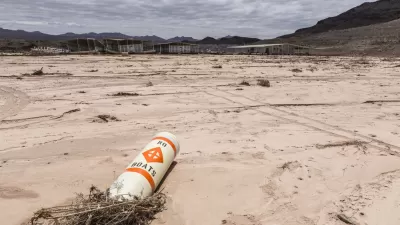A recent article details the rapid growth, evaporating surface storage capacity, and manicured lawns worsening drought conditions in Texas (no, not California).
Writing for Next City, Sara Goodyear details the facts and figures behind the under-reported story of Texas’ drought—which is approaching catastrophic levels in some parts of the state. “The drought map for the state of Texas from April 8 of this year isn’t pretty. As of the end of March, 67 percent of the state — up from 46 percent four months ago — suffered from moderate or worse drought conditions, according to the Texas Water Development Board. Twenty-five percent of the state is in ‘extreme’ drought or worse, and rainfall has been scant over the last 90 days.”
The drought has reduced levels at some of the reservoirs in the state to less than ten percent capacity. Adds Goodyear: “Not only the reservoirs are drying up. Groundwater levels are also on a downward trajectory in many parts of the state, as are stream flows — although reservoirs are particularly vulnerable because of evaporation.”
In an effort to be proactive about the drought, voters recent authorized $2 billion in water-related infrastructure spending to deal with the drought. But critics say the spending will neglect fundamental problems with the state’s management of its water supply. The first project to come online of the drought, for instance, is a surface storage facility that will send water to a suburb of the notoriously water inefficient Dallas.
Given the state’s quick population growth, Goodyear expresses concern that “the conflict between rural and urban water interests is bound to intensify if the drought continues.”
FULL STORY: To Deal With Drought, Texas Needs to Manage Growth

Planetizen Federal Action Tracker
A weekly monitor of how Trump’s orders and actions are impacting planners and planning in America.

Maui's Vacation Rental Debate Turns Ugly
Verbal attacks, misinformation campaigns and fistfights plague a high-stakes debate to convert thousands of vacation rentals into long-term housing.

Cuomo Is the Candidate of Both NIMBYs and Developers. What Gives?
In the New York City mayoral race, odd bedfellows align to preserve the housing status quo.

San Antonio and Austin are Fusing Into one Massive Megaregion
The region spanning the two central Texas cities is growing fast, posing challenges for local infrastructure and water supplies.

Charlottesville Temporarily Has No Zoning Code
A judge ordered the Virginia city to throw out its newly revised zoning code, leaving permitting for new development in legal limbo.

In California Battle of Housing vs. Environment, Housing Just Won
A new state law significantly limits the power of CEQA, an environmental review law that served as a powerful tool for blocking new development.
Urban Design for Planners 1: Software Tools
This six-course series explores essential urban design concepts using open source software and equips planners with the tools they need to participate fully in the urban design process.
Planning for Universal Design
Learn the tools for implementing Universal Design in planning regulations.
Heyer Gruel & Associates PA
JM Goldson LLC
Custer County Colorado
City of Camden Redevelopment Agency
City of Astoria
Transportation Research & Education Center (TREC) at Portland State University
Jefferson Parish Government
Camden Redevelopment Agency
City of Claremont





























